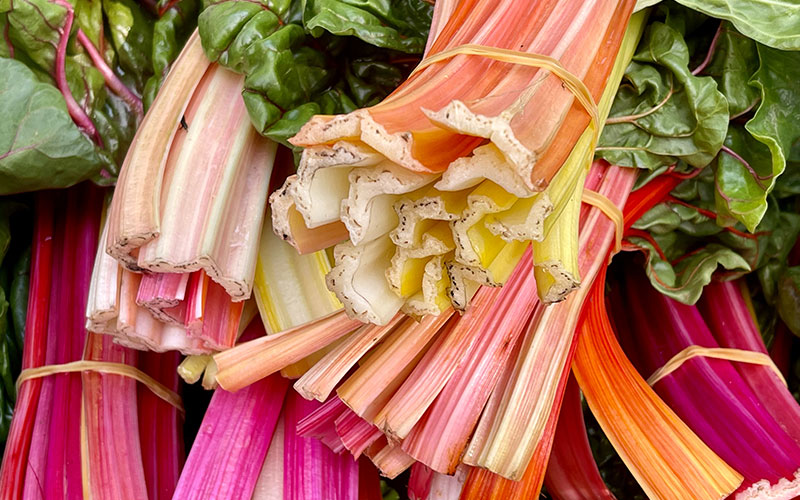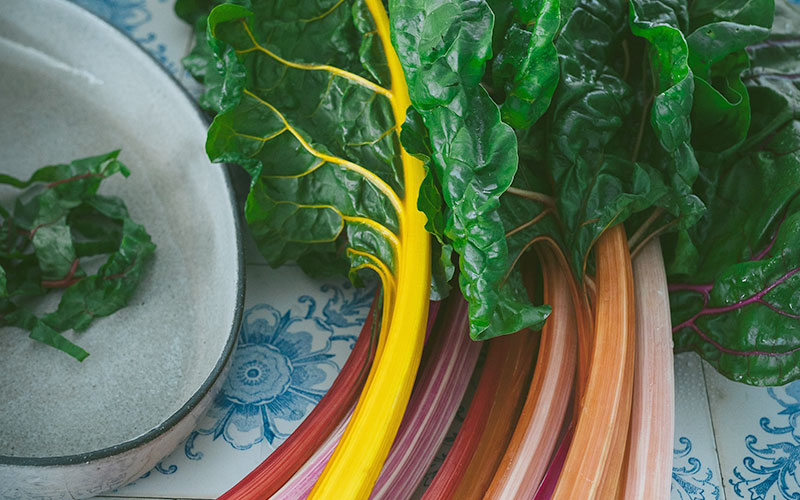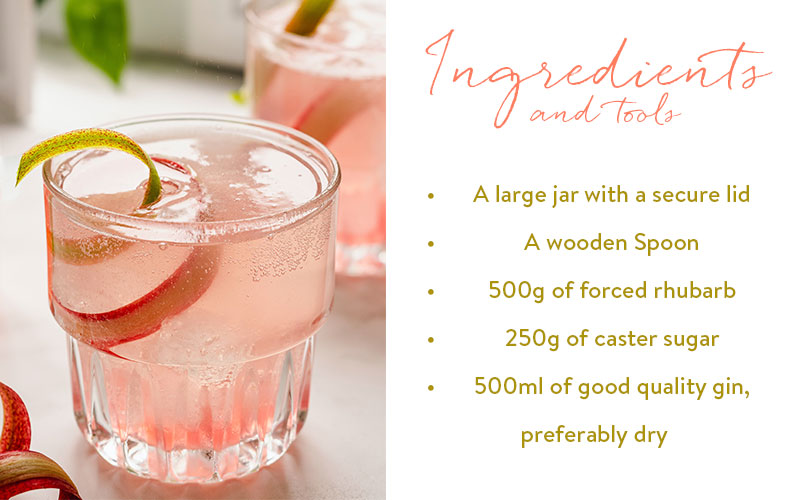Cocktails come and go but the classic flavours never go out of style and rhubarb gin is one of those drinks that is just perfect for long summer nights, but equally enjoyable at Christmas parties with some ginger thrown in for added spice.
It’s not a tricky recipe and once you have your basic homemade gin you can get creative and make your own versions of classic cocktails. Some of the traditional flavours that go well with rhubarb gin include ginger, orange, lemon, lime, strawberry, and of course it can be combined with other drinks including tonic, soda water and ginger beer.
The first thing you are going to need is some rhubarb and as this is not available in the shops all year round, why not have a go at growing your own, so that you have an endless and free supply of this essential plant to create your unique rhubarb gin recipe.

How to grow your own rhubarb
The rhubarb plant has large leaves but it’s the stalks that you use to make your rhubarb gin. The plant stalks are often pink or red in colour and can also be used to make pies, crumbles and other puddings.
How sweet or sharp your rhubarb will taste, will depend on how young or old the leaf stems are that you use, but its very easy to grow and the plants tend to flourish year on year, providing multiple crops, so you might need a big freezer.
Growing your first plants
In general, rhubarb is grown from the crowns of other rhubarb plants but you can grow from seedlings or even seeds if you prefer.
Generally, plants need to be started off indoors in March or April, and will need protection from insects.
As they grow, you can move them outside in the autumn or the next spring if its predicted to be a particularly harsh winter.
How to care for your rhubarb plants
During the summer months your plants will need regular watering to support growth. If they get too hot they will stop growing altogether and you won’t get a good yield.
It’s particularly important to regularly water rhubarb that is kept in pots.
Each spring you can support your rhubarb by giving them a new layer of compost around them as this will provide nutrients and help to keep the plant strong and moist.
In the Autumn the leaves will die away and you can cut back the old ones. Rhubarb needs around eight weeks of cold weather.

Continuing to cultivate your rhubarb
As your rhubarb becomes established you might need to split large plants that have clumped together as they will start to become too crowded which will stop them growing effectively.
You can remove the crown of the plant around November, and divide it into sections to create more plants. Make sure each one has root and a growing point and then you can replant them.
Don’t allow your plant to grow flowers
If your rhubarb starts to flower you need to remove the flower stalks as these will weaken your plants.
Not all rhubarb has flowers but this can happen. Also, avoid growing your rhubarb in areas where it might get frost.
Harvesting your rhubarb stalks
Now we come to the interesting part – harvesting your rhubarb stalks ready to prepare them so you can start creating your amazing rhubarb gin.
After you have planted your rhubarb, don’t harvest in it’s first year as the plant won’t be strong enough.
Pick a few stems in the second year of growth and then after that you can harvest as you please, although take care not to over harvest as your plants will be left weak.

Don’t leave your plant too weak to grow
The stalks remain edible throughout the summer but the ideal time to harvest is from the end of April through to June, and then to let your plant rest and re-establish itself, otherwise you risk weakening its growth permanently.
The best way to harvest, is to take hold of the leaf stalk right at the base of the plant, and try to pull it out from the ground without actually breaking it from the plant. Never take more than a third of the leaf stems.
What exactly is forced rhubarb?
Many rhubarb gin recipes do call for you to use forced rhubarb for a better flavour. Forced rhubarb just means forcing the plant to produce sweeter and more tender stems.
This is achieved by covering the plant with a bin, or some other covering so that the stalks are developed in the dark.
These forced stalks are then harvested in early March, way before plants which grow naturally in the light.
The reason is to have an earlier crop and also to make the most of the sweeter flavour of these forced stems.
Best rhubarb varieties for forced rhubarb
Not all rhubarb plants will cope with the forced method of growing so here are some of the best varieties to look out for if you do intend to follow the forced rhubarb approach for making your homemade rhubarb gin:
Giant grooveless crimson
This plant is not as acidic as many breeds and can be harvested early, producing vibrant red stalks, hence its name.
Raspberry red
This variety actually develops very sweet red stems without any forcing and can be harvested from April to June.
Stockbridge
This is the most commonly used rhubarb for commercial growers and is the most popular variety when it comes to forcing rhubarb. It yields very large crops of stems.

Recipe for homemade rhubarb gin
Make rhubarb gin
As with most rhubarb gin recipes, we are recommending using the bright pink or red forced rhubarb stems as they tend to be much less sharp in flavour and create the beautiful pink colour that is associated with this amazing drink.
You might also want to have on hand some other extra ingredients to enhance the flavour later, or if you are planning to make some cocktails, although you will need to leave your gin for at least a week before you can drink it, so that it becomes fully infused with the rhubarb.
This recipe will make around 650ml of rhubarb gin, giving you plenty to start of with and you can always increase the amount of ingredients if you want to make a big batch for a party or special occasion. Everything in the recipe is suitable for vegetarians.
Ingredients
- A large jar with a secure lid
- 500g of forced rhubarb – the rhubarb needs to be washed and trimmed into slices around half a centimetre thick.
- 250g of caster sugar
- 500ml of good quality gin, preferably dry
Options for extra flavour if required
- Half a vanilla pod, split
- Four slices of fresh ginger
- Two pieces of star anise
- Blood orange zest
- Juniper
- Coriander seed
- Elderflower
- Cardamom
- Black pepper
- Cinnamon
- Angelica root
- Lemon zest
Instructions
Prepare your jar by washing and drying it thoroughly. Your sterilised jar needs to be large enough to hold all of your ingredients securely and needs to have a secure lid as well as you will need to tip it to mix the ingredients over time.
Having washed and trimmed your rhubarb, place it all into the bottom of the jar and then add in the sugar.
Use a wooden spoon to stir the rhubarb into the sugar to ensure every piece is thoroughly coated.
If you are going to be using any of the additional ingredients for extra flavour, you need to add these into the gin jar now and mix them in with the rhubarb.
We aren’t recommending you add all of the listed options, just choose one or two that suit your palate.
You now need to put on the lid and leave overnight as this will allow all of the sugar to dissolve into the fruit and this will bring out all of the juice from the rhubarb.
The next day, you can open the jar and pour in all of the gin, to fully cover all of the ingredients.
You will need to give the gin a really good stir, then close the jar again and leave it to one side for one week at the very least.
If possible, leave it for a month, to really draw out all of the flavours and to get the best result. You can shake the gin jar each day to help pull out even more of the rhubarb flavour and juices each time.
When you are ready to drink your newly created tipple, you will need to empty the jar by sieving the gin through a fine strainer, into a handy jug and then you can pour it into an empty gin bottle for storage, or serve it immediately.

The best ways to serve your rhubarb gin
The best way to serve your pink gin is in a tall glass with ice, and tonic water, or fresh ginger beer, but of course that’s very traditional.
If you are more adventurous then you will definitely want to try using your amazing homemade rhubarb gin to create delicious cocktails.
Here are some great examples of rhubarb gin cocktails you can easily try at home with your new batch of pink gin:
The Negroni
This is a variation on a classic cocktail and makes best use of your newly created pink gin. The somewhat bitter and spicy flavour of the rhubarb-based liqueur Zucca Rabarbaro help to contrast with your gin’s sweet taste.
To make this cocktail, you will need only three ingredients:
- 37.5ml of your rhubarb gin
- 30ml of the Rabarbaro
- 22ml of sweet Vermouth
Simply combine all the measures into a glass, add ice, stir briefly and garnish with an orange slice and you have made your first rhubarb gin cocktail at home.
The Queen
This sweet cocktail features a rhubarb and strawberry syrup, as well as the sweet rhubarb gin, but combined with Campari which brings its own dry and citrus flavours to balance it out, making this a delightful summer evening drink to enjoy in the garden.
To make this cocktail, all you will need are the following:
- 45ml of your rhubarb gin
- 15ml of Campari
- 22ml of lemon Juice
- 15ml of rhubarb and strawberry syrup
- One egg white
- A cocktail shaker
Add all of the ingredients into your cocktail shake and mix them together with a good shake for around 20 seconds. Then add ice to the shaker and mix again for around 10 seconds, before pouring out and serving in a cocktail glass.
Perfect pineapple
This cocktail combines the sweetness of your gin, with the acidity of pineapple and the dryness of a Vermouth to create a really refreshing cocktail that everyone will enjoy at your summer barbecue or garden party.
To make this final rhubarb gin cocktail, you will need:
- 30ml of your rhubarb gin
- 30ml of Vermouth
- 22ml of pineapple syrup
- 22ml of lemon juice
- Ice
- Sprig of fresh mint for garnish
Simply pour all of the ingredients into a tall glass and stir with a stirrer before adding the ice, garnishing with a sprig of fresh mint and serve immediately for another refreshing rhubarb gin cocktail to enjoy with great company for a great evening.
Whether you choose to buy your rhubarb from a greengrocer or farm shop, or decide to go ahead and grow your own in the garden or greenhouse, making your own rhubarb gin is incredibly easy and once you have your first batch, you can start to get creative, trying out different flavours and making your own homemade signature cocktails.

You can even create a signature bottle and use your delicious gin as a great idea for gifts for your friends and family. If it’s not to their taste, you can always personalise it, for example, you could add sugar, lemon, lime or other delicious flavours to make the bottle very personal.
Keeping your gin in a cool dark place in the bottle will help to keep it fresh and remain delicious. The longer you keep it the more the flavours will infuse and the better it will be for drinking.
If you’re looking for gin related gifts for friends and family, check out Virginia Hayward’s gin hampers for a range of great gift ideas.
